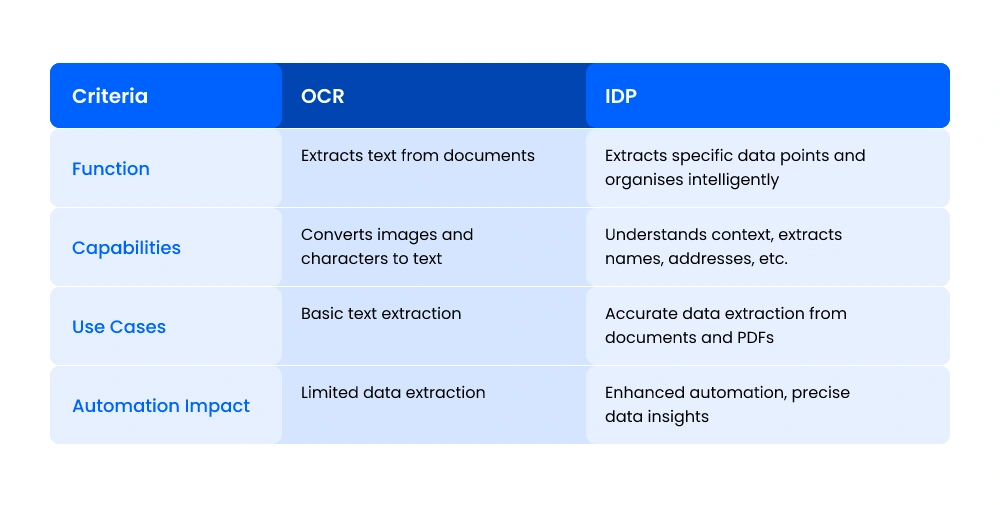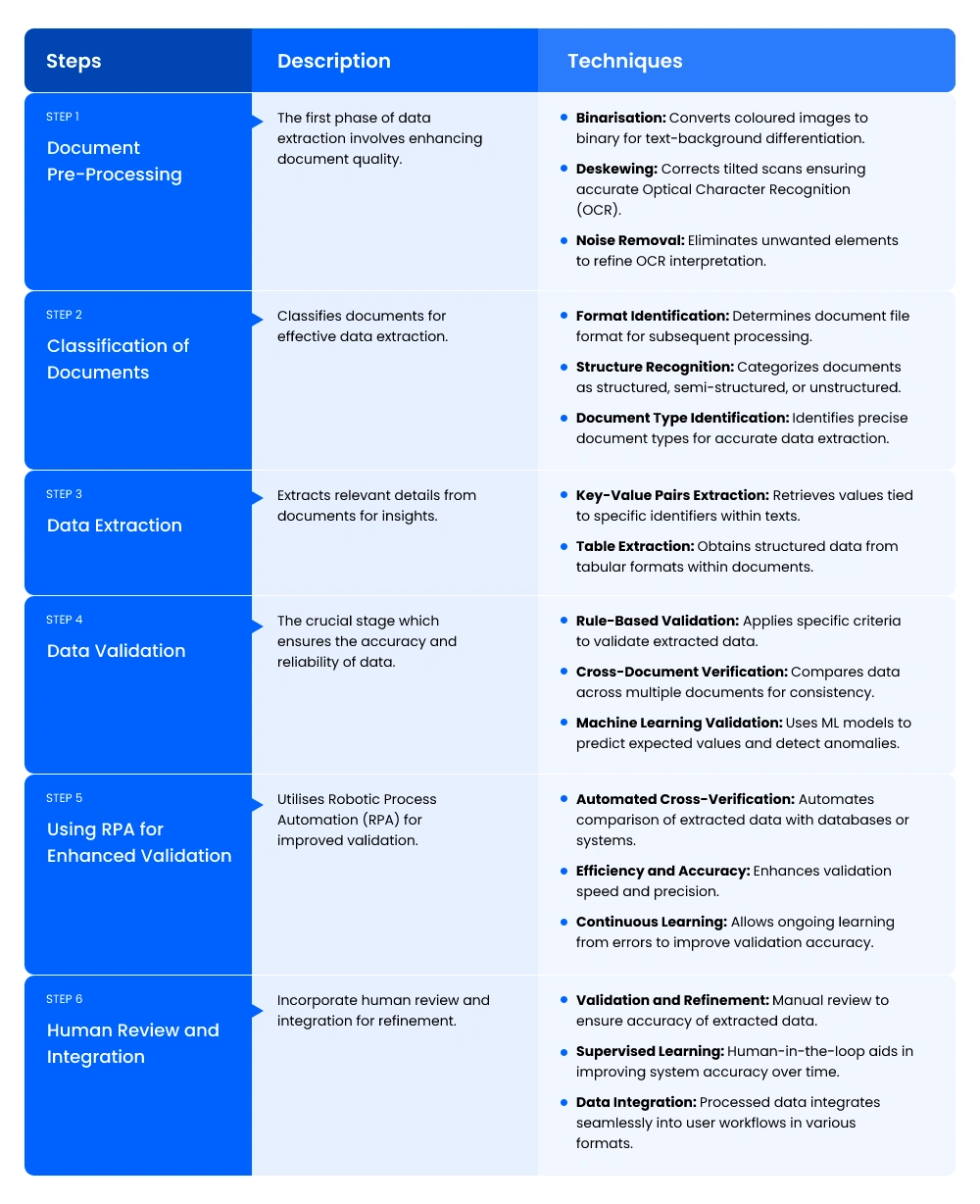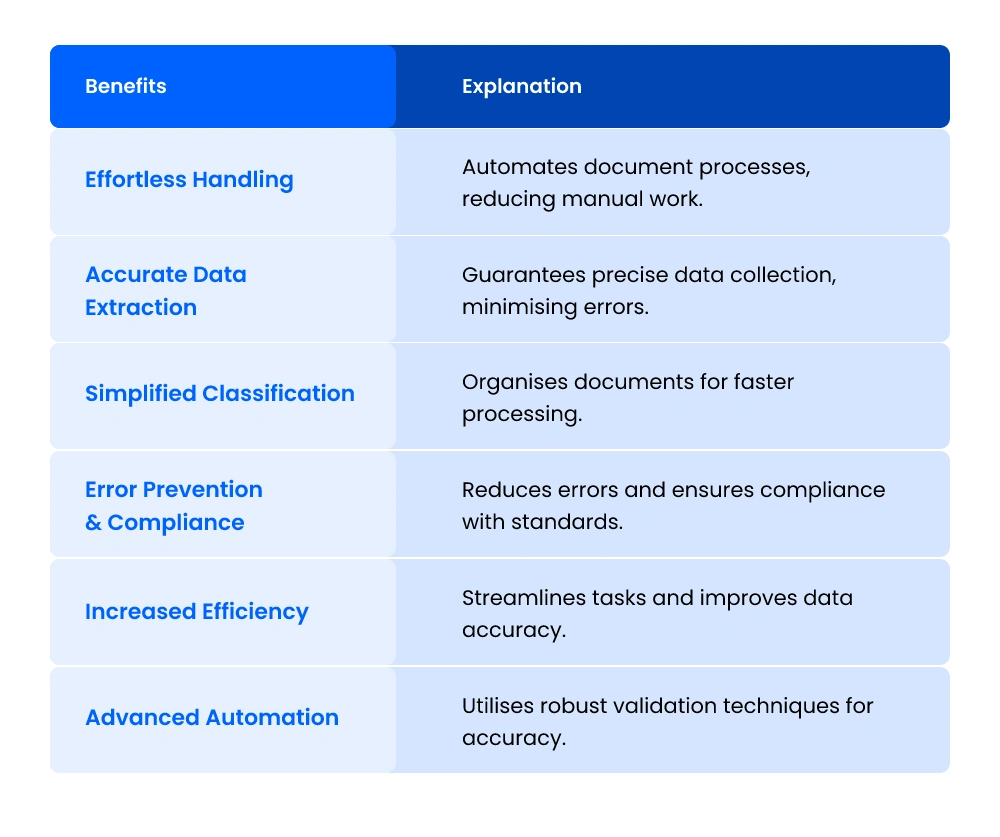All You Need to Know About Intelligent Document Processing (IDP)
In today’s digital age, keeping track of and discovering vital information in hundreds of documents can be difficult. “According to IDC’s prediction, the size of the global datasphere is expected to reach 163 zettabytes (one trillion gigabytes) by 2025. Manually processing the growing amount of invoices and other documents is not only costly and time-consuming but also error-prone.” This is where Intelligent Document Processing (IDP) enters, a game changer in handling documents, data extraction automation, and workflow optimisation.
This Comprehensive blog post will walk you through the world of IDP, including its elements, features, procedures, benefits, industry applications, software selection, implementation methodologies, and best practices.
Understanding Intelligent Document Processing (IDP)
Intelligent document processing, also known as IDP, handles a wide variety of unstructured, semi-structured, and structured documents with the help of artificial intelligence (AI) and machine learning. This cutting-edge technology makes custom declaration easier and enables systems to examine and interpret document data in a manner comparable to human understanding.
With the development of technology, advanced functions are added to IDP, such as natural language processing (NLP). Thanks to this evolution, document processing is much more advanced than just character recognition; systems can now understand and interpret the content they are processing. Nevertheless, in spite of these developments, IDP has long been restricted to business process outsourcing, also known as BPO divisions.
A revolutionary transition towards contemporary intelligent document processing is currently taking place. While previous systems mainly dealt with text and field data extraction, modern IDP integrates content into employee and consumer experience.
Main Components of Intelligent Document Processing (IDP)

Optical Character Recognition (OCR)
This remarkable technology is part of customs software that can transform scanned documents and images into easily editable text. With OCR, the previously non-editable text becomes flexible, making it capable of being used for various applications.
Natural Language Processing (NLP)
This is capable of understanding human language and interpreting it helpfully. In Intelligent Document Processing, Natural Language Processing plays a crucial role in handling unstructured text in various documents and extracts the intent and context behind the language.
Machine Learning and Artificial Intelligence (AI)
They have revolutionised the field of Intelligent Document Processing (IDP). These cutting-edge technologies enable IDP systems to gain insight from data, resulting in improved pattern recognition, decision-making capabilities, and enhanced accuracy in data extraction, making trade compliance simpler. This continuous improvement method allows IDP to adapt and refine its techniques, improving performance and precision.
Buried in paperwork?
Stop wasting time on manual processing & automate with IDP!
Understanding the Differences: IDP vs. OCR

Intelligent Document Processing (IDP) and Optical Character Recognition (OCR) are essential for managing unstructured data. Despite their similarities, they all have distinct qualities that meet various demands for data extraction.
OCR is a fundamental technique widely used to extract text from digital and physical materials. Its main job is to convert specific words, characters, and images into machine-readable text by scanning through them. OCR essentially links digital systems and physical documents by converting the content into text that can be processed, edited, and searched.
On the other hand, IDP marks a substantial advancement in document processing technology. Beyond text recognition, it can understand and extract specific data points, such as names, addresses, or dates, from various document formats, including PDFs. This capability extends beyond OCR. Its effectiveness is not limited to text extraction; it also plays a role in comprehending the contextual significance of the data included in the documents. With this knowledge, IDP can intelligently identify documents and arrange them in formats that are appropriate for easy integration.
Typical OCR is helpful for simple text extraction from damaged text or images. In comparison, IDP ensures accuracy and efficiency in extracting data from documents and PDFs.
The main difference between the two is how deeply they can interpret a given piece of data: IDP is a more advanced and potent tool for contemporary document automation and processing, whereas OCR only extracts text.
By delving deeper into the features, uses, and advantages of OCR and IDP, the information gets more comprehensive and offers a clearer picture of each technology’s functions in document processing and data extraction.
Why Should Businesses Use Intelligent Document Processing (IDP)?

There are several compelling reasons why organisations should think about implementing Intelligent Document Processing:
Efficiency
IDP optimises operational efficiency through automated document management, which entails data extraction from a wide range of formats, including contracts, forms, and invoices. This system frees up staff members to focus on other major tasks by eliminating the need for manual labour.
Accuracy
The advanced functions of IDP guarantee the accurate extraction of important data points, including dates, names, and addresses, minimising the chances of errors that could arise in manual work.
Time Savings
IDP expedites document workflows, resulting in increased work efficiency and quicker decision-making by automating data extraction.
Scalability
IDP can readily grow to accommodate large document volumes as businesses expand without sacrificing precision or efficiency, making it flexible enough to meet changing business requirements.
Security and Compliance
IDP lowers the possibility of errors or non-compliance problems while guaranteeing accurate data extraction, which enhances compliance. It frequently has robust security features to safeguard private data contained in documents.
Analytics and Insights
Intelligent document processing makes data analysis easier by retrieving organised data from unstructured documents, helping companies get important insights and make decisions based on data.

Worried about data accuracy & compliance?
Eliminate human error & compliance risks with iCustoms' IDP!
How Does Intelligent Document Processing (IDP) Work?

Step 1: Document Pre-Processing
Document pre-processing is the first step of data extraction in IDP. This critical phase includes techniques, such as OCR (Optical Character Recognition), to improve document quality for precise extraction.
Techniques for Document Processing
Binarisation: This step separates text from the background by converting coloured images into a binary format. Differentiating these components allows for more precise identification in the OCR process.
Deskewing: A slight tilt may arise in scanned documents, which may hamper the accuracy of OCR. Different techniques, such as Projection Profile, correct these tilts, which guarantees that the text is horizontally aligned for accurate character recognition.
Noise Removal: It minimises the possibility of misinterpretation by removing tiny, undesired components like dots or patches, ensuring that OCR correctly interprets only actual characters.
Step 2: Classification of Documents
The next step is to classify the documents. This phase entails comprehending the kind and structure of documents to ensure effective data extraction.
Phases of Document Classification:
Format Identification: Whether the file is in a TIFF, PNG, PDF, JPG, or another supported format, the system first determines its format. This identification is necessary for the processing that comes next.
Structure Recognition: Three categories are applied to documents:
- Semi-structured
- Unstructured
- Structured
Semi-structured documents have different layouts but the same content, whereas structured documents follow a standard format. Unstructured documents don’t have an established format.
Document Type Identification: Determining the precise document type, such as invoices, contracts, or any other papers, ensures accurate extraction based on pre-established models and data training.
Step 3: Data Extraction
The IDP’s data extraction phase entails retrieving relevant details from documents, which is an essential procedure for organisations to extract practical insights from their data.
Techniques for Extracting Data
Key-Value Pairs Extraction: This technique ensures accurate data retrieval by finding and extracting values linked to particular key identifiers within texts.
Table Extraction: In many texts, extracting data organised in tables is essential. The procedure entails correctly identifying and obtaining structured data from tabular formats.
Step 4: Data Validation
Validation is a crucial stage in the IDP process that guarantees the dependability and accuracy of the extracted data.
Techniques for Extracting Data
Rule-Based Validation: This method ensures that extracted data meets predetermined standards by applying particular rules. For example, comparing the tax payable and invoice’s subtotal to the total payable amounts.
Cross-Document Verification: To detect inconsistencies and preserve data consistency, data from several documents or sources are compared.
Machine Learning Validation: Machine learning models that have been trained on past data are used to ensure the accuracy of data validation. This allows the system to predict predicted results and identify irregularities.
Step 5: Using RPA for Enhanced Validation
IDP workflows have advanced substantially using Robotic Process Automation (RPA) to improve validation processes.
The Use of RPA in Validation
Automated Cross-Verification: RPA effectively compares extracted data with databases or other systems by automating cross-verification processes. For example, it may quickly cross-reference client data from documents with the company’s database entries.
Efficiency and Accuracy: RPA’s rapidity and accuracy in completing these duties expedite the validation process, minimising delays.
Continuous Learning: RPA and machine learning together allow for constant learning, highlighting any errors in the validation and improving its accuracy over time.
Step 6: Human Review and Integration
IDP’s process includes a critical human element, such as manual review and integration.
Human-In-The-Loop Process
Validation and Refinement: During the extraction process, documents highlighted for possible inaccuracies are subject to human involvement to help with validation and refinement.
Supervised Learning: The human-in-the-loop technique aids the system’s supervised learning. Repeated cycles, ongoing amendments, and feedback improve the model’s accuracy.
Data Integration: After being verified and improved, the processed data effortlessly integrates into the customer’s workflow. It is offered in various formats, such as JSON, XML, and PDF, to meet different system needs.
Unlocking the Benefits of Intelligent Document Processing (IDP)

Effortless Document Handling
By automating some document processing operations, Intelligent Document Processing simplifies document handling. It lessens the need for manual labour in processes like validation, classification, and data extraction.
Accuracy in Data Extraction
Intelligent Document Processing guarantees accuracy and precision in gathering pertinent data from different documents. It carefully recognises and collects necessary information, minimising errors, using top-notch technologies like OCR.
Simplified Classification and Sorting
Intelligent Document Processing organises and classifies documents effectively. It separates documents into categories, such as unstructured, semi-structured, and structured, and arranges them in the appropriate order for faster processing.
Error Prevention and Compliance
Intelligent Document Processing considerably lowers data extraction errors and guarantees adherence to predetermined guidelines or standards, improving data accuracy. This is done by automating procedures and utilising validation techniques.
Increased Accuracy and Efficiency
IDP system automates document intelligence by streamlining operations and automating repetitive duties to increase overall efficiency. Over time, it also improves the accuracy of extracted data through ongoing learning and improvement.
Advanced Automation and Validation
IDP uses advanced validation techniques like robotic process automation, which allows for robust validation procedures.
Which Industries Use Intelligent Document Processing (IDP)?

The following industries commonly use Intelligent Document Processing (IDP):
Lending Sector
Loan Processing: Intelligent document processing uses automation to gather and check loan documentation, including income statements, proofs, and credit reports. This expedites the approval process by quickly examining and verifying the relevant data.
Risk Assessment: By gathering and evaluating information from credit reports and financial documents, IDP helps lenders make well-informed decisions quickly, reducing the associated risks.
Insurance Industry
Claims Processing: IDP simplifies the insurance claim documentation and verification procedure. It speeds up the review and settlement process by extracting important data from medical records, claim forms, and supporting documentation.
Policy Administration: Keeping track of insurance policies requires a lot of paperwork. IDP assists with processing and organising policy-related documentation, guaranteeing accuracy in policy updates.
Logistics
Shipment Documentation: Intelligent Document Processing manages a range of shipment paperwork, including custom forms, invoices, and bills of lading. It organises and extracts data to speed up the customs declaration process and ensure proper billing.
Compliance Forms: In logistics, keeping track of compliance documentation is essential. IDP helps ensure compliance with rules by effectively processing compliance forms.
Commercial Real Estate
Lease agreements: IDP extracts and organises important information for easy management of lease agreements. This simplifies tenant communication, lease changes, and renewals.
Property Documentation: With IDP, managing property-related documents such as contracts, titles, and deeds becomes more effective, enabling better organisation and access to vital data.
Management of Accounts Payable
Processing of Invoices: Intelligent Document Processing simplifies and automates invoice data extraction, guaranteeing precision. This results in speedier approval processes and on-time payments, as well as better relationships with suppliers and financial management.
Choosing the Right IDP Software

Document automation benefits you in many ways with the help of IDP software:
Intelligent Document Processing (IDP) Overview
This first step entails getting familiar with IDP, comprehending its fundamental features, and learning how it helps document digitalisation. It’s critical to understand the potential advantages that IDP may offer for streamlining business procedures.
Understanding Your Company's Needs and Objectives
It’s essential to pinpoint the unique needs and goals of your company. In this step, the tasks related to document processing that require automation are assessed, along with the number of documents, compliance requirements, and the intended results of implementing IDP.
Important Things to Consider When Selecting IDP Software
A number of variables are important when choosing the best IDP software. These can include the degree of support offered, customisation possibilities, security features, ease of use, scalability, and compatibility with current systems.
Assessing and Comparing IDP Software
This stage entails looking into and contrasting the several IDP options on the market. To find the one that best fits your business needs, evaluate its features, functions, user interface, pricing structures, and customer testimonials.
Effective Decision-Making
By selecting the IDP software that aligns most closely with your organisation’s long-term objectives, financial resources, and requirements, you will make an informed choice based on the assessments and comparisons.
Implementation and Ongoing Improvement
Once you have selected the IDP software, the implementation stage starts. This includes setting up the system, integrating it with current systems, and giving users the required training. Furthermore, as part of continuous improvement, the program’s performance is routinely evaluated, user input is gathered, and any necessary modifications are made to maximise its efficiency.
Need help matching your business needs with the perfect IDP solution?
Talk to iCustoms' experts!
The Bottom Line
Intelligent Document Processing (IDP) offers accuracy and efficiency in document management for various industries. Selecting the right software guarantees smooth integration, increases efficiency, and opens the door for future technological advancements in document processing.
Discover how iCustoms can help your business take advantage of Intelligent Document Processing (iDP). Boost your operations by automating data extraction, revolutionising document management, and gaining valuable insights.
Discover the power of IDP with iCustoms today!

Ready to automate & free up your team’s time?
Experience IDP's efficiency with a free demo!
FAQ's
What is intelligent document processing?
Intelligent document processing is a technique that automates data extraction and analysis from documents using artificial intelligence (AI) and machine learning.
How does intelligent document processing work?
IDP extracts, sorts, and analyses data from documents using various technologies, including machine learning methods, Optical Character Recognition, and natural language processing.
What is the difference between OCR and intelligent document processing?
OCR is a subset of intelligent document processing. OCR extracts text from photos and converts it to editable text; on the other hand, IDP includes additional features like data extraction, categorisation, and analysis in addition to OCR.
What is document intelligence?
The term "document intelligence" describes a system's capacity to use machine learning and artificial intelligence methods to comprehend, evaluate, and extract insights from documents.
You may also like:
Struggling to Extract, Categories & Validate Your Documents?
Capture & Upload Data in Seconds with AI & Machine Learning
Subscribe to our Newsletter
About iCustoms
Struggling to Extract, Categories & Validate Your Documents?
Capture & Upload Data in Seconds with AI & Machine Learning